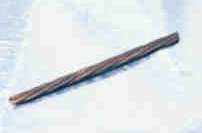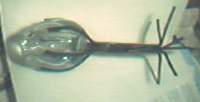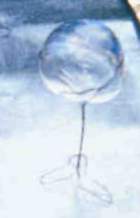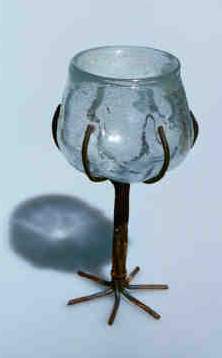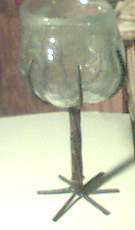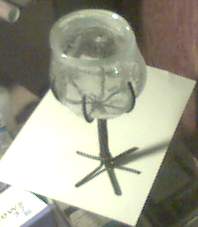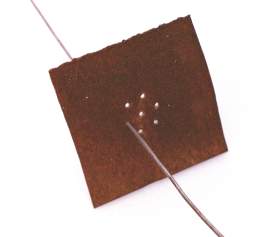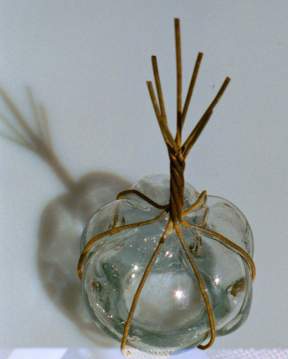|
This page collects information for my site about blowing
glass into metal forms, mostly my explorations, but some general info.
|
||||||||||||||||||||||||||
|
History - Metal shapes to receive
blown glass are nothing new, although older items known to me are just
glass lined food and drink containers where the mold or hand blown glass
fits into a metal form to safely hold the food. Today metal lamp and vase forms with glass bulging through designed openings can be found in garden and decorative centers imported from Mexico and China. |
||||||||||||||||||||||||||
|
Techniques and Tools - If
my goal is to work the lip of the glass in the goblet, then I have to be able to
return the glass to the glory hole after taking it off the pipe, which means I
have to have it mounted on a punty. (Glossary)
Among choices would be to leave a hole in the bottom of the metal form to attach
to the glass, which affects the design choices for the piece. Another choice
would be a large version of the prong gripper that is
used in making light glass goblets and by lampworkers and I actually built a
version and came up with a revised design, but
realized as I cast some units that a different plan was needed - the gripper was
not strong enough and depended on a disk type base. |
||||||||||||||||||||||||||
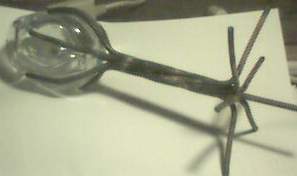 The
wire goblet stems I fooled around with were unmanageable
unless given good handle and the central wire provided the clue to a solution
for the problem: I could provide a small hole to take the wire, hold the
leg with a retainer and release the hot metal and cooling glass into the
annealer. It would not be difficult to add a rod to a cast goblet. The
wire goblet stems I fooled around with were unmanageable
unless given good handle and the central wire provided the clue to a solution
for the problem: I could provide a small hole to take the wire, hold the
leg with a retainer and release the hot metal and cooling glass into the
annealer. It would not be difficult to add a rod to a cast goblet. |
||||||||||||||||||||||||||
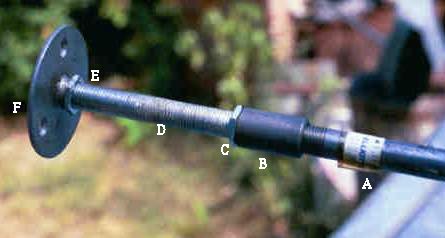 Punty built for wire stem goblets
- the outer end which has been braised in and drilled to only 3/16" (4.76
mm) to center the wire.on the foot plate/floor flange at left. There is an
angled
hole drilled in the side of the all thread (D on the other side) to permit running
a wire down the inside to hold a leg of the punty, but both so far I have used
light wire twisted through one of the holes in the plate to hold the wire stem,
cutting it with diagonal cutters just before putting it in the annealer.
Punty built for wire stem goblets
- the outer end which has been braised in and drilled to only 3/16" (4.76
mm) to center the wire.on the foot plate/floor flange at left. There is an
angled
hole drilled in the side of the all thread (D on the other side) to permit running
a wire down the inside to hold a leg of the punty, but both so far I have used
light wire twisted through one of the holes in the plate to hold the wire stem,
cutting it with diagonal cutters just before putting it in the annealer.This unit makes use of common plumbing parts and not quite so common lamp parts. The threaded portions size is what is called 1/4" IPS water or gas pipe, which is actually just over 1/2" OD. Black iron pipe 4' long (A) takes a coupling (B) and a piece of fully threaded pipe used in lamp making (D) which has two lock nuts on it (C, E) and a floor flange (F) which is used to mount pipe as handrail or shower rod. Black iron is used because galvanized gives off nasty fumes when heated. |
||||||||||||||||||||||||||
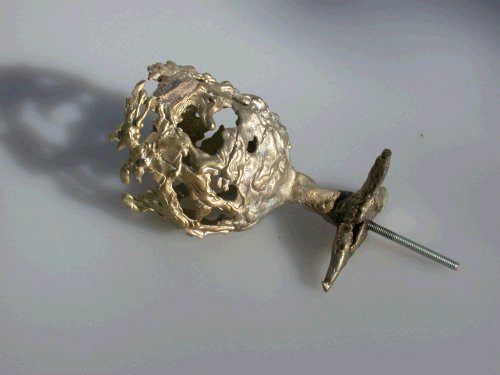 This
tool was rebuilt changing the long all-thread (D) to a much shorter piece which
was filled with portion of a bolt that was center drilled and threaded 8-32. (result)
to take a knob making mandrel. This in turn was used for to mount a cast
goblet with a threaded rod in the bottom. This
tool was rebuilt changing the long all-thread (D) to a much shorter piece which
was filled with portion of a bolt that was center drilled and threaded 8-32. (result)
to take a knob making mandrel. This in turn was used for to mount a cast
goblet with a threaded rod in the bottom.I got an email asking how I had time to install it on the punty while working and the answer is that I don't try - the metal shape in installed before I start. The question is based on the glass working method where a bubble is used to pick up hot color or a color cup from a kiln. I mount the base to the punty cold, sliding or threading the rod into the hole in the punty and then securing the base from rotation. I heat the unit in the gloryhole or in my hanging glass garage, and prop the punty at an angle with the open cup pointing at me from below waist level with the handle end of the punty on the ground. I am not inserting the glass in the cup while the cup sits on the ground or something and then attempting to put the glass/base unit on the punty. If I had a situation where the only way I could get the glass into the cup was to come straight down, then I would mount the punty vertically and go up a ladder or stand to get above it - kind of like Stephen Rolfe Powell does here (scroll up and down.) |
||||||||||||||||||||||||||
|
When I first tried blowing into the brass and the aluminum castings,
putting the hot glass in the metal would chill the glass - stopping it from
moving - and heat the metal - expanding it - leaving the glass loose in the
metal and very awkward for working the lip, which was my goal. So I took the
metal part, already mounted on the punty, and preheated it in the glory hole
with one hand while maintaining the bubble/parison with the other. I could have
used my special glass garage
for the same purpose. With the metal already warm (not forgetting that aluminum
melts at about 1300F and brass/bronze at about 1800F) it was already expanded
mostly and did not chill the glass as much so the glass could follow/flow to
fill better. Something has to be done to keep the base from rotating on the
punty. I tried various techniques, including trying to
screw it in very tight and running a wire up the shaft and out the side, but
found that using soft steel wire around one of the feet of my stem wired through
a hole in the flat end of the punty worked the best. Obviously, if the foot were
round, it would be a problem. I suspect I would cast on a stub if it were round
to keep it from rotating and to be cut off after blowing. |
||||||||||||||||||||||||||
|
Design Factors - When blowing into metal for later working of the lip, and to a certain extent for later use, it may be necessary to avoid a perfectly round shape either by using an oval plan view or by providing indentions that provide a rotational grip on the glass. I looked at some of the glass in metal works of Tiffany shown at the local museum and found features that suggested to me a choice of providing a piece that could be bent into the glass after annealing to pressure the glass, like the prongs on jewel settings in metal. The brass/bronze metal I am using is very stiff and would resist bending. As mentioned just above, if a design calls for a base that does not have a
leg sticking out - a disk or a ball - it may be necessary to design into the
casting a stub for wiring that is removed like the sprues but after blowing
rather than before. |
||||||||||||||||||||||||||
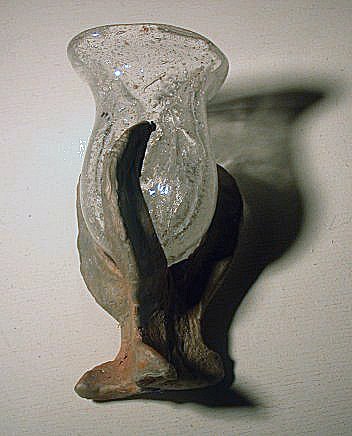 While
some of my brass designs are heavy in weight, the aluminum ones are
intentionally designed to be fairly thick to provide as much heat sink
capability to reduce the melting that might occur on reheating. Shown here
are a tree form with sprues not yet removed and a tri-form after blowing the
glass into it but before clean up of the metal surface. While
some of my brass designs are heavy in weight, the aluminum ones are
intentionally designed to be fairly thick to provide as much heat sink
capability to reduce the melting that might occur on reheating. Shown here
are a tree form with sprues not yet removed and a tri-form after blowing the
glass into it but before clean up of the metal surface.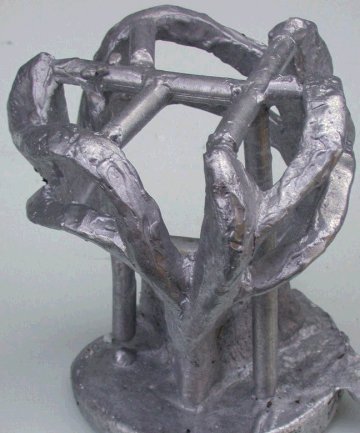 |
||||||||||||||||||||||||||
| Wire Rope Goblet Stems | ||||||||||||||||||||||||||
I explored other packs for having choices in design and having a central wire for grip if I needed it.
|
